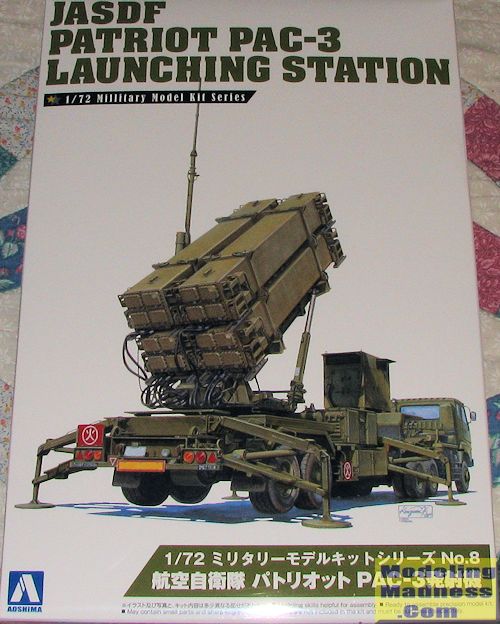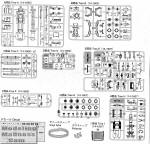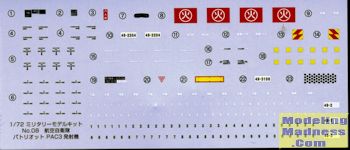
Aoshima 1/72 Patriot PAC-3
| KIT #: | 009956 |
| PRICE: | SRP is around $57.00 |
| DECALS: | One option |
| REVIEWER: | Scott Van Aken |
| NOTES: | New tool kit |

| HISTORY |
The MIM-104 Patriot is a surface-to-air missile (SAM) system, the primary of its kind used by the United States Army and several allied nations. It is manufactured by the U.S. defense contractor Raytheon and derives its name from the radar component of the weapon system. The AN/MPQ-53 at the heart of the system is known as the "Phased Array Tracking Radar to Intercept On Target" or the bacronym PATRIOT. The Patriot System replaced the Nike Hercules system as the U.S. Army's primary High to Medium Air Defense (HIMAD) system, and replaced the MIM-23 Hawk system as the U.S. Army's medium tactical air defense system. In addition to these roles, Patriot has been given the function of the U.S. Army's anti-ballistic missile (ABM) system, which is now Patriot's primary mission.
Patriot uses an advanced aerial interceptor missile and high-performance radar systems. Patriot was developed at Redstone Arsenal in Huntsville, Alabama, which had previously developed the Safeguard ABM system and its component Spartan and hypersonic speed Sprint missiles. The symbol for Patriot is a drawing of a Revolutionary War-era Minuteman.
Patriot systems have been sold to Taiwan, Egypt, Germany, Greece, Israel, Japan, Kuwait, the Netherlands, Saudi Arabia, United Arab Emirates, Jordan and Spain. Poland hosts training rotations of a battery of U.S. Patriot launchers. It was first deployed in Morąg in 24 May 2010 but has since been moved to Toruń and Ustka. South Korea also purchased several second-hand Patriot systems from Germany after North Korea test-launched ballistic missiles to the Sea of Japan and proceeded with underground nuclear testing in 2006. On 4 December 2012, NATO authorized the deployment of Patriot missile launchers in Turkey to protect the country from missiles fired in the civil war in neighboring Syria.
The PAC-3 upgrade is a significant upgrade to nearly every aspect of the system. It took place in three stages, and units were designated Configuration 1, 2, or 3.
The system itself saw another upgrade of its WCC and its software, and the communication setup was given a complete overhaul. Due to this upgrade, PAC-3 operators can now see, transmit, and receive tracks on the Link 16 Command and Control (C2) network using a Class 2M Terminal or MIDS LVT Radio. This capability greatly increases the situational awareness of Patriot crews and other participants on the Link 16 network than are able to receive the Patriot local air picture. The software can now conduct a tailored TBM search, optimizing radar resources for search in a particular sector known to have ballistic missile activity, and can also support a "keepout altitude" to ensure ballistic missiles with chemical warheads or early release submunitions (ERS) are destroyed at a certain altitude. For Configuration 3 units, the Patriot radar was completely redesigned, adding another travelling wave tube (TWT) that increased the radar's search, detection, tracking, and discrimination abilities. The PAC-3 radar is capable, among other things, of discriminating whether or not an aircraft is manned and which of multiple reentering ballistic objects are carrying ordnance.
The PAC-3 upgrade carried with it a new missile design, nominally known as MIM-104F and called PAC-3 by the Army. The PAC-3 missile evolved from the Strategic Defense Initiative's ERINT missile, and so it is dedicated almost entirely to the anti-ballistic missile mission. Due to miniaturization, a single canister can hold four PAC-3 missiles (as opposed to one PAC-2 missile per canister). The PAC-3 missile is also more maneuverable than previous variants, due to 180 tiny pulse solid propellant rocket motors mounted in the forebody of the missile (called Attitude Control Motors, or ACMs) which serve to fine align the missile trajectory with its target to achieve hit-to-kill capability. However, the most significant upgrade to the PAC-3 missile is the addition of a Ka band active radar seeker. This allows the missile to drop its uplink to the system and acquire its target itself in the terminal phase of its intercept, which improves the reaction time of the missile against a fast-moving ballistic missile target. The PAC-3 missile is accurate enough to select, target, and home in on the warhead portion of an inbound ballistic missile. The active radar also gives the warhead a "hit-to-kill" (kinetic kill vehicle) capability that completely eliminates the need for a traditional proximity-fused warhead. However, the missile still has a small explosive warhead, called Lethality Enhancer, a warhead which launches 24 low-speed tungsten fragments in radial direction to make the missile cross-section greater and enhance the kill probability. This greatly increases the lethality against ballistic missiles of all types.
The PAC-3 upgrade has effectively quintupled the "footprint" that a Patriot unit can defend against ballistic missiles of all types, and has considerably increased the system's lethality and effectiveness against ballistic missiles. It has also increased the scope of ballistic missiles that Patriot can engage, which now includes several intermediate range. However, despite its increases in ballistic missile defense capabilities, the PAC-3 missile is a less capable interceptor of atmospheric aircraft and air-to-surface missiles. It is slower, has a shorter range, and has a smaller explosive warhead compared to older Patriot missiles.
Patriot's PAC-3 interceptor was to be the primary interceptor for the new MEADS system, which was scheduled to enter service alongside Patriot in 2014. 29 November 2012 – The Medium Extended Air Defense System (MEADS) detected, tracked, intercepted and destroyed an air-breathing target in its first-ever intercept flight test at White Sands Missile Range, N.M.
Lockheed Martin Missiles and Fire Control is the prime contractor on the PAC-3 Missile Segment upgrade to the Patriot air defense system which will make the missile more agile and extend its range by up to 50%. The PAC-3 Missile Segment upgrade consists of the PAC-3 missile, a very agile hit-to-kill interceptor, the PAC-3 missile canisters (in four packs), a fire solution computer, and an Enhanced Launcher Electronics System (ELES). The PAC-3 Missile Segment Enhancement (MSE) interceptor increases altitude and range through a more powerful dual-pulse motor for added thrust, larger fins that collapse inside current launchers, and other structural modifications for more agility.
| THE KIT |
 Aoshima's
kit is molded in a very dark grey plastic. The molding is first rate on all the
parts and I didn't see any pesky ejector pin marks on upper surfaces. Several of
the large parts (trailer bed, truck cab and such), had them on the under side or
inside where they will not be easily seen. The kit also includes a rather
extensive clear sprue. Some polycaps and vinyl tubing (air lines for the
trailer) are also included.
Aoshima's
kit is molded in a very dark grey plastic. The molding is first rate on all the
parts and I didn't see any pesky ejector pin marks on upper surfaces. Several of
the large parts (trailer bed, truck cab and such), had them on the under side or
inside where they will not be easily seen. The kit also includes a rather
extensive clear sprue. Some polycaps and vinyl tubing (air lines for the
trailer) are also included.
Surprisingly, this is not a curbside as Aoshima has included a basic, but complete engine. A lot of time is spent on the main truck part as you have to assemble the suspension as well as the drive train which, being all wheel drive and having three axles is rather complex. The front wheels have separate hubs and tires while on the rear duals, the outer tire is molded to the wheel. Glass for the cab is installed from the inside so you will either have to paint the cab prior to clear installation or do some masking. The interior is nicely done for the scale and includes full front seats, instrument panel and steering wheel. Decals are used for instruments and various placards through the kit build. There really is a lot to do when building the tractor section as that takes up 28 of the 43 construction steps.
The rest is for the trailer. This is two major
sections and like the tractor, you have to build up the suspension. Wheels are
separate wheel and tire sections. There are various equipment boxes and
generators that need to be built before one can start to attach the Patriot
missile boxes. These are separate items and need to be built is a specific
sequence. Though a single missile is included, this is for show as the missile
boxes are not designed to be open. The missile canister assembly can be built
either extended for firing or in the transport mode. There is a different sized
actuator for this so this section does not seem to be movable. The stabilization
outriggers can be built either retracted or extended. All of the missile canisters are connected with very
short sections of vinyl tubing.
retracted or extended. All of the missile canisters are connected with very
short sections of vinyl tubing.
| CONCLUSIONS |
Overall, it is a very nice kit and while it does have a lot of parts, careful construction will result in a very nice model and one that will look great on your display shelf.
| REFERENCES |
http://en.wikipedia.org/wiki/MIM-104_Patriot
January 2015 Thanks to
www.dragonmodelsusa.com for the peview kit. You can find
this kit at your favorite hobby shop
or on-line retailer. If you would like your product reviewed fairly and fairly quickly, please
contact
the editor or see other details in the
Note to
Contributors.